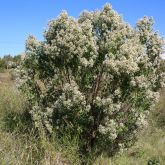Groundsel bush

Groundsel bush flowers
© Queensland Government

Groundsel bush plant form
© Queensland Government

Groundsel bush leaf
© Queensland Government

Groundsel bush leaves
© Queensland Government

Groundsel bush plant form
© Queensland Government
Native to the USA, groundsel bush is a dense, woody shrub particularly suited to moist and coastal areas.
Groundsel bush was introduced to the Brisbane region as an ornamental plant before 1900. Now found in coastal parts of Queensland and northern New South Wales, it competes with both native and pasture vegetation and can be a serious weed in young forestry plantations. The spread of groundsel bush threatens the sustainability of agriculture and other land uses.
You must manage the impacts of Groundsel bush on your land.
You must not give away, sell or release Groundsel bush into the environment.
Scientific name
Other names
- Consumption weed, eastern baccharis, groundsel tree
Description
- Densely branched shrub up to 3m tall.
- Stems are green when young, brown and woody when mature.
- Taproots are deep and branching, with numerous fibrous laterals in upper soil.
- Leaves are dull green, alternate, wedge-shaped, 2.5–5cm long, 1–2.5cm wide.
- Male flowers are pale yellow, opening mid- to late March, slightly earlier than female flowers.
- Female flowers are white, inconspicuous, at ends of branches.
- Seeds are brown, 3mm long, with tufts of white hair.
Habitat
- Particularly suited to moist gullies, saltmarsh areas and wetlands.
- Found in forests, disturbed sites, pastures and waste areas.
Distribution
- Found in coastal areas of South East Queensland.
- Rarely found west of Great Dividing Range.
- Visit Weeds Australia and click on the distribution tab to access the distribution map.
Life cycle
- Seeds are fully developed in late March to early April.
- Most germination occurs in autumn/winter period.
Affected animals
- Native animals
- Humans
Impacts
Environmental
- Replaces plants and destroys native wildlife habitat.
- Can become abundant in vegetation along watercourses and in coastal woodlands and forest areas.
Economic
- Competes with pasture species for water and nutrients.
- Serious weed of forestry plantations in first year of planting.
Social
- Germinates in home gardens.
- Causes allergies induced by airborne pollen and seed fluff.
How it is spread
- Seeds spread by wind, running water, vehicles and machinery.
Prevention
Control
Mechanical control
- Hand-pull small plants.
- Dig larger plants out or cut them off more than 10cm below ground level.
- As groundsel bush is a perennial woody plant with underground growing buds, slashing or burning will rarely kill plants and will generally result in regrowth. Control regrowth promptly.
Herbicide control
- Herbicides are effective.
Read the Groundsel bush fact sheet (PDF, 3.8MB) for herbicide control and application rates.
Biological control
- More than 35 different insects have been tested since 1967, with 6 now permanently established:
- stem borer (Megacyllene mellyi)
- plume moth (Hellinsia balanotes)
- gall-fly (Rhopalomyia californica
- groundsel bush leaf beetle (Trirhabda bacharidis)
- leaf skeletoniser (Aristotelia ivae)
- leaf miner (Bucculatrix ivella)
- Rust fungus Puccinia evadens from Florida was also released in 1998 and is now established. Infection requires a moisture film on leaf or stem surface. Dry spores are spread by wind.
- Three agents Puccinia evadens, Hellinsia balanotes and Rhopalomyia californica are thought to contribute to control over most of weed's range.
Legal requirements
- Groundsel bush is a category 3 restricted invasive plant under the Biosecurity Act 2014.
- You must not give away, sell or release groundsel bush into the environment. Penalties may apply.
- You must take all reasonable and practical measures to minimise the biosecurity risks associated with dealing with Groundsel bush under your control. This is called a general biosecurity obligation (GBO).
- At a local level, each local government agency must have a biosecurity plan that covers invasive plants in its area. This plan may include actions to be taken on certain species. Some of these actions may be required under local laws. Contact your local council for more information.